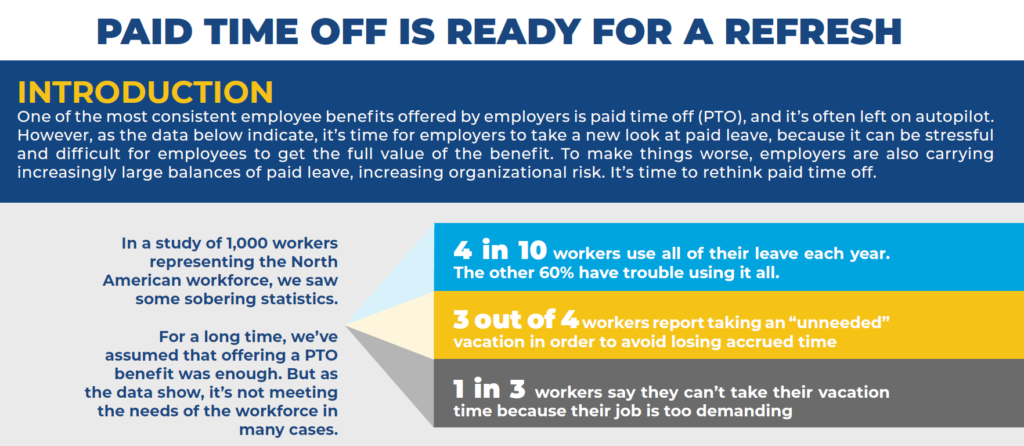9 out of 10 Workers Would Stay at Your Company if They Had this Benefit [Report]
For a long time, employers have offered paid time off (PTO) as a way to provide flexibility to the workforce to meet their personal needs. However, new data shows that PTO isn’t as good at meeting those needs as we thought.
Why? There are a number of reasons that are outlined in the new report. In a study that included responses from 1,000 PTO-eligible workers at jobs from multiple industries, we found that different demographic groups had barriers to taking all of their paid leave. For instance:
- Income gaps: 56% of workers making less than $49,000 a year use all their vacation time, but 72% of those making over $125,000 do. Lower income workers are less likely to be able to take advantage of this benefit to its full extent, citing too much work followed by concerns about job security and manager perceptions.
- Gender gaps: in the study we found that women were 43% less likely than men to say that they use all their leave every year, citing hesitancy around how they would be perceived at work, job worries, or lack of ability to afford a vacation.
- Racial gaps: Nonwhite employees are 19% less likely to take all their leave every year compared to white workers, with the ability to afford a vacation showing slightly higher for this group.
Not only that, but the research also uncovered something startling. During the pandemic, about 80% of workers took less time off due to travel restrictions and other limitations. In a year when we needed time, rest, and recovery more than ever, the majority of the workforce was unable to take advantage of that benefit, with many of them losing any hours if the company didn’t allow rollovers of leave from year to year.
Why This Research, and Why Now?
The focus of this research was to understand employee perceptions of this benefit, but it was also used to gauge their interest in a new flexible type of paid leave option that gives the workforce and employers more control. In our research, we see flexibility rise in importance, and flexibility in benefits actually ranks higher for workers than remote work!
Thanks to new technology, employers can leverage innovative tools that convert paid leave into things employees need, including everything from emergency cash savings and retirement savings to charitable contributions and donations to coworkers in need. Speaking of donating, four out of five workers say they would gladly give some of their paid leave to a coworker that experienced an emergency.
In the report we outline the degree to which employees would prefer these types of benefits to more traditional PTO plans, and we also uncover an employee retention statistic that is mind-blowing: 9 out of 10 workers say this type of benefit would make them more likely to stay with their current employer.

Ben Eubanks is the Chief Research Officer at Lighthouse Research & Advisory. He is an author, speaker, and researcher with a passion for telling stories and making complex topics easy to understand.
His latest book Talent Scarcity answers the question every business leader has asked in recent years: “Where are all the people, and how do we get them back to work?” It shares practical and strategic recruiting and retention ideas and case studies for every employer.
His first book, Artificial Intelligence for HR, is the world’s most-cited resource on AI applications for hiring, development, and employee experience.
Ben has more than 10 years of experience both as an HR/recruiting executive as well as a researcher on workplace topics. His work is practical, relevant, and valued by practitioners from F100 firms to SMB organizations across the globe.
He has spoken to tens of thousands of HR professionals across the globe and enjoys sharing about technology, talent practices, and more. His speaking credits include the SHRM Annual Conference, Seminarium International, PeopleMatters Dubai and India, and over 100 other notable events.

